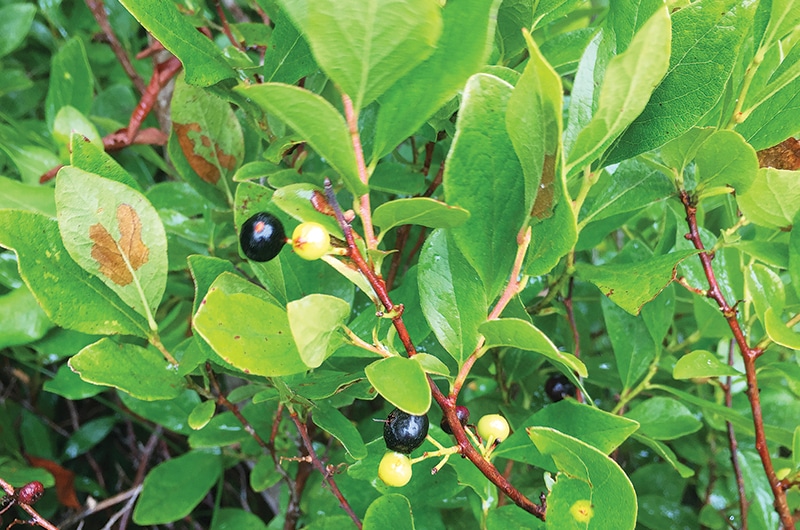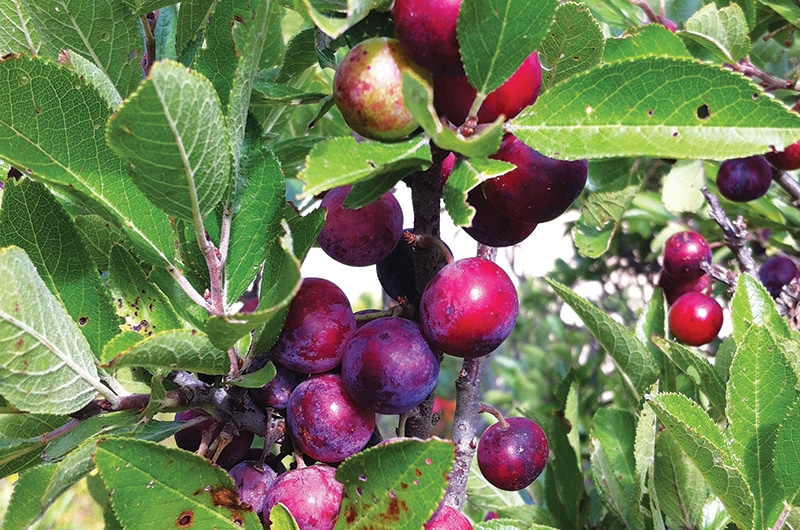by Dr. Sarah T. Bois, Director of Research & Education for the Linda Loring Nature Foundation
Berry season is upon us on Nantucket. While the strawberries have come and gone, there is a plethora of native, wild berries available for the picking. In and among the grasslands and heathlands of Nantucket, there are a multitude of shrubs soon almost heavy with fruit. So get out those berry pails and sterilize the canning jars, because you are in for a bountiful harvest.
The first to come into fruit should be familiar. The low bush blueberries are just ripening by mid to late July. Low to the ground, these plentiful berries are great picking for kids and adults. They are generally much smaller than what you would buy in the grocery store, but oh so much sweeter. With plenty of plants to pick from, you can easily fill a small pail for a pie or cobbler.
Lowbush means the high bush blueberries are soon to follow. This looks like a bumper crop year for the high bush blueberries. As their name implies, high bush are much larger and more dispersed than their shorter counterparts. These are the larger berries more often seen in the produce section. One note about wild high bush blueberries is that, as long-lived shrubs, they sometimes stop fruiting in later years. In cultivation, these shrubs are heavily pruned and often burned every so many years to increase fruit production. If you can find some plants in an area of the south coast that has recently been managed, you might be more likely to find some big blues.

Black huckleberries, my personal favorite, often go underappreciated. The dark purple/black berries are plentiful as this shrub is one of the most dominant of Nantucket’s native shrubs. Found throughout the moors, south coast, and heathlands, black huckleberry fruit at the end of July-early August. They are slightly sweeter than a blueberry with a similar taste. The tiny seeds can be eaten (just like a blueberry), but have a little crunch to them that adds texture. These are great berries on top of ice cream, in pies and cobblers, or just as a snack while rambling in the moors.
Ever hear of dewberries? They are what many people refer to as blackberries that grow wild all over Nantucket. All in the same genus (Rubus), dewberries are closely related to blackberries and raspberries. There are multiple species of Rubus growing wild on the island and all are edible. You just need to know which ones are ripe when red and which ones you need to wait until they turn black. I tend to pick sour ones more often than not, but when you get a sweet one warm from the summer sun, all the sour ones seem worth it.

Towards the middle of August, the beach plums finally ripen. The fruit are a dark purple when ripe like the familiar plums, though smaller than plums found in the store. The stone in the center makes it slightly difficult to process, but beach plums make wonderful jams and jellies. While still a common native, beach plums are less plentiful than some of the other species mentioned. Because of that, dedicated beach plum foragers will stake out their favorite shrubs early in the season and regularly check on their progress. There is also a golden variety found sporadically around Nantucket with warm yellow fruit that is even scarcer. A good beach plum spot is like a good fishing spot, you only share with the ones you love and you still may need to blindfold them.
Rose hips are also ripe for the picking in August, though usually only the true aficionados go for the hips. Not technically berries, rose hips are the fruit of a rose plant. Only the large rose hips from Rosa rugosa (beach rose) are big enough for foraging. The flesh can be eaten without eating the core (like an apple). The hips are high in vitamin C, but not very tasty eaten in the field. Those dedicated will make jelly or jam, but they still fun to try if you encounter them on the way to the beach.
September will bring ripening fox grape. You’ll know when they’re ripe because you’ll often smell them before you see them. With four pretty big seeds in each grape, they take a it to chew, but they are sweeter than any store bought grape. A batch of jelly is a good fall project and a prized possession when given as a gift.
So get out there and forage! Just remember a few things before you go:
• Pick only what you are able to use. The birds and animals are also depending on the berry bounty and we don’t want to over-harvest this resource.
• Make sure you have permission to pick in your location of choice. Don’t go picking on private property!
• Remember that most of the conservation land on Nantucket is private property. That said, most conservation properties are open to the public. Be respectful, don’t make new trails, and don’t over-harvest.
• Know the hazards. Poison ivy, another native plant, grows all over the island often hiding in plain sight. Make sure your berry patch is PI free before picking, and always check yourself for ticks when you get home.


